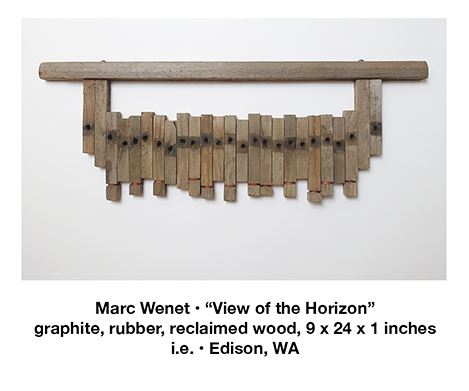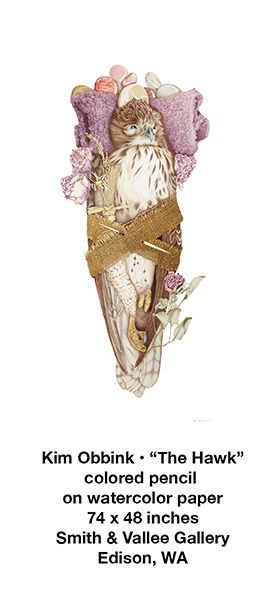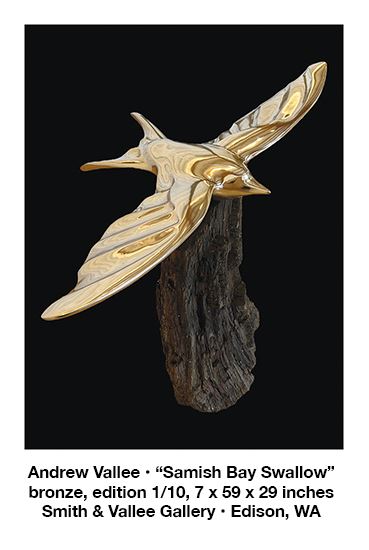
As summer draws to a close and the days get shorter, both the natural colors and art exhibitions change in the Skagit Valley. This seems an appropriate time to discuss a tour of the valley through its art galleries and venues, many of which feature artists local to the region. These stops include the perennial favorites in Edison (i.e., and Smith & Vallee Gallery) along with new friends in Mount Vernon at Leonard Brothers Fine Art, and a delightful stop at the Bitters Co. barn curated by owners/sisters Amy and Katie Carson. In the end, visitors see excellent art from regional artists while also taking in the bountiful beauty of the valley.
It makes sense to start our day in Edison with visits to i.e. and Smith & Vallee Gallery. In September, i.e. features a memorial exhibition for John Schaefer and sculptures by Michael Clough. In October, the gallery features a solo show of work by Marc Wenet. Schaefer’s color field paintings are intense; strokes of red, black, and gray fill the picture plane and light emanates from his circular forms. The works are meditative, just like Michael Clough’s carved rocks that accompany Schaefer’s paintings in the exhibition. The artist’s hand is evident in all these works. Viewers can see the movement of the oil in Schaefer’s work while Clough hand carves the rocks, which makes the work extremely personal.

In October, i.e. highlights the work of Marc Wenet, a Seattle-based artist who creates assemblages from found materials and who recently began adding his mark on the materials by applying colored pencil and gouache. His sculptures often have humorous elements as the artist brings a humanistic quality to the combination of various found objects. Almost like figures standing in line, Wenet’s objects bring years of history together through the gathered materials.
While the exhibitions at i.e. explore materials and our intimate connection to those objects, the exhibitions at Smith & Vallee Gallery turn to representations of the natural world. Their September exhibition brings together Kim Obbink’s detailed colored pencil drawings of animals, flowers, and other gathered items, with Annie Burke’s ceramic sculptures.

The gallery typically pairs two artists together in their shows, but October brings a solo exhibition of work by Andrew Vallee. Vallee began his career as a furniture and cabinet maker and has used those woodworking skills in his sculpture practice. Recent travels back and forth across the Pacific Ocean from Edison to Hawaii have inspired the artist to venture into two-dimensional work. The resulting paintings and mixed media artworks are gestural and colorful interpretations of the artist’s travel experiences.
Skagit Valley is home to many historic barns, and a visit to Bitters Co. provides a unique opportunity to go inside one of these iconic red barns. Bitters Co. is a design and development company that specializes in houseware, including glassware, bakeware, and other furnishings created by craftspeople in various countries around the world. The barn is open for shopping by appointment, and the Carson sisters sell their wares as wholesale. They also host events and art exhibits in this idyllic location.
From September 16 to October 14, the Bitters Co. barn welcomes the work of Joe Max Emminger to celebrate the harvest season. Emminger is a self-taught painter who paints the world around him constantly, nearly every day according to the artist. The works in the exhibition are acrylic on paper and painted objects that the artist gathers from around his home. Emminger’s paintings are colorful, and his characters are instantly recognizable to those familiar with his work. While his scenes are often quite whimsical and humorous, the viewer can’t help but think that a more sinister message is underneath. In this exhibition, the artist focuses on the theme of “harvest,” and the characters gather as they accumulate bounty from throughout the paintings.

Downtown Mount Vernon is home to a new gallery: Leonard Brothers Fine Art. Visitors to the picturesque downtown area can add this as a stop for their art-viewing pleasure, along with Perry and Carlson Gallery. The new gallery features a newly remodeled interior complete with crisp walls and optimal lighting for artwork. The gallery opened in May 2023, and curator/artist David Kane has taken the opportunity to highlight artists in both solo and group exhibits. Sculpture and two-dimensional work by Peter Belknap occupy the gallery through September, and the gallery hosts the art of beloved Edison artist, chef, and shop owner David Blakesley in October. Art lovers rarely have this great opportunity to appreciate a gallery full of Blakesley’s art, so this is a unique treat.
Chloé Dye Sherpe
Chloé Dye Sherpe is a curator and art professional based in Washington State.

Galleries in Edison, Washington:
i.e., located at 5800 Cains Court, is open Friday through Sunday, from 11 a.m. to 5 p.m. Visit www.ieedison.com for information.
Smith & Vallee Gallery, located at 5742 Gilkey Avenue, is open Thursday through Monday, from 11 a.m. to 5 p.m. Visit www.smithandvalleegallery.com for information.

Galleries in Mount Vernon, Washington:
Bitters Co., located at 14034 Calhoun Road, is open Thursday through Sunday, from 11 a.m. to 4 p.m. Visit www.bittersco.com for information.
Leonard Brothers Fine Art, located at 511 South 1st Street, is open Friday through Sunday, from 12 to 6 p.m. Visit www.lbfa.us for information.
Perry and Carlson Gallery, located at 504 South 1st Street, is open daily from 11 a.m. to 6 p.m. Visit www.perryandcarlson.com for information.